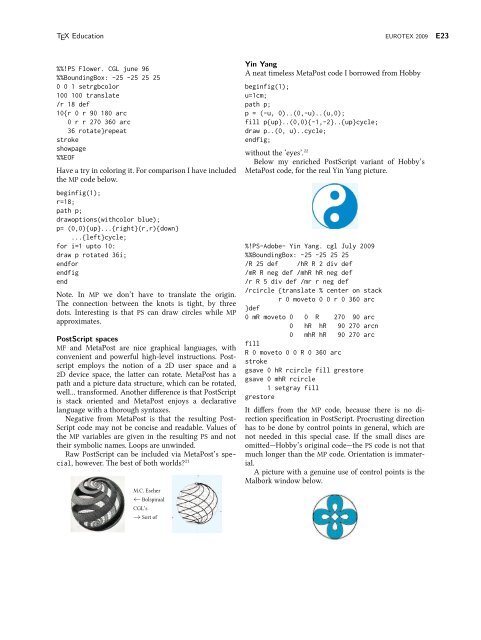Complete issue 30:3 as one pdf - TUG
Complete issue 30:3 as one pdf - TUG
Complete issue 30:3 as one pdf - TUG
You also want an ePaper? Increase the reach of your titles
YUMPU automatically turns print PDFs into web optimized ePapers that Google loves.
TEX Education EUROTEX 2009 E23<br />
%%!PS Flower. CGL june 96<br />
%%BoundingBox: -25 -25 25 25<br />
0 0 1 setrgbcolor<br />
100 100 translate<br />
/r 18 def<br />
10{r 0 r 90 180 arc<br />
0 r r 270 360 arc<br />
36 rotate}repeat<br />
stroke<br />
showpage<br />
%%EOF<br />
Haveatryincoloringit.ForcomparisonIhaveincluded<br />
the MPcode below.<br />
beginfig(1);<br />
r=18;<br />
path p;<br />
drawoptions(withcolor blue);<br />
p= (0,0){up}...{right}(r,r){down}<br />
...{left}cycle;<br />
for i=1 upto 10:<br />
draw p rotated 36i;<br />
endfor<br />
endfig<br />
end<br />
Note. In MP we don’t have to translate the origin.<br />
The connection between the knots is tight, by three<br />
dots. Interesting is that PS can draw circles while MP<br />
approximates.<br />
PostScript spaces<br />
MF and MetaPost are nice graphical languages, with<br />
convenient and powerful high-level instructions. Postscript<br />
employs the notion of a 2D user space and a<br />
2D device space, the latter can rotate. MetaPost h<strong>as</strong> a<br />
path and a picture data structure, which can be rotated,<br />
well...transformed.AnotherdierenceisthatPostScript<br />
is stack oriented and MetaPost enjoys a declarative<br />
language withathorough syntaxes.<br />
Negative from MetaPost is that the resulting Post-<br />
Script code may not be concise and readable. Values of<br />
the MP variables are given in the resulting PS and not<br />
their symbolicnames. Loopsare unwinded.<br />
Raw PostScript can be included via MetaPost’s special,<br />
however. The best ofboth worlds? 21<br />
M.C. Escher<br />
←Bolspiraal<br />
CGL’s<br />
→Sortof<br />
Yin Yang<br />
Aneat timelessMetaPostcode Iborrowed from Hobby<br />
beginfig(1);<br />
u=1cm;<br />
path p;<br />
p = (-u, 0)..(0,-u)..(u,0);<br />
fill p{up}..(0,0){-1,-2}..{up}cycle;<br />
draw p..(0, u)..cycle;<br />
endfig;<br />
withoutthe ‘eyes’. 22<br />
Below my enriched PostScript variant of Hobby’s<br />
MetaPostcode, forthe realYinYangpicture.<br />
%!PS-Adobe- Yin Yang. cgl July 2009<br />
%%BoundingBox: -25 -25 25 25<br />
/R 25 def /hR R 2 div def<br />
/mR R neg def /mhR hR neg def<br />
/r R 5 div def /mr r neg def<br />
/rcircle {translate % center on stack<br />
r 0 moveto 0 0 r 0 360 arc<br />
}def<br />
0 mR moveto 0 0 R 270 90 arc<br />
0 hR hR 90 270 arcn<br />
0 mhR hR 90 270 arc<br />
fill<br />
R 0 moveto 0 0 R 0 360 arc<br />
stroke<br />
gsave 0 hR rcircle fill grestore<br />
gsave 0 mhR rcircle<br />
1 setgray fill<br />
grestore<br />
It diers from the MP code, because there is no direction<br />
specication in PostScript. Procrusting direction<br />
h<strong>as</strong> to be d<strong>one</strong> by control points in general, which are<br />
not needed in this special c<strong>as</strong>e. If the small discs are<br />
omitted—Hobby’s original code—the PS code is not that<br />
much longer than the MP code. Orientation is immaterial.<br />
A picture with a genuine use of control points is the<br />
Malborkwindow below.

















